

The 5th ‘C’ of 21st Century Skills? Try Computational Thinking (Not Coding) For better or worse, computing is pervasive, changing how and where people work, collaborate, communicate, shop, eat, travel, learn and quite simply, live. From the arts to sciences and politics, no field has been untouched. The last decade has also seen the rise of disciplines generically described as “computational X,” where “X” stands for any one of a large range of fields from physics to journalism. Here’s what Google autocomplete shows when you type “computational.” (You can try it for yourself!) But the big question is: Does current K-12 education equip every student with the requisite skills to become innovators and problem-solvers, or even informed citizens, to succeed in this world with pervasive computing?
Since the turn of this century, the “4C’s of 21st century” skills—critical thinking, creativity, collaboration and communication—have seen growing recognition as essential ingredients of school curricula. Bers2019 Article CodingAsAnotherLanguageAPedago. Coding Robots for STEAM Learning. Center for Computational Thinking, Carnegie Mellon. What is computational thinking?
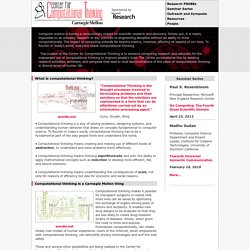
"Computational Thinking is the thought processes involved in formulating problems and their solutions so that the solutions are represented in a form that can be effectively carried out by an information-processing agent. " Teaching Resources. March 2011 computational thinking ll386. Computational Thinking. Computational Thinking. Marco_de_evaluacion_ICILS_2018. Algoritmos e inteligencia artificial: ¿por donde empezar? Listado de algunas referencias indispensables para empezar el camino hacia una alfabetización sobre algoritmos e inteligencia artificial.
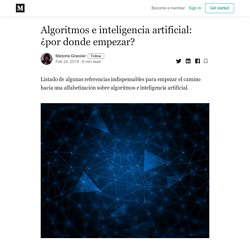
Computer Science for Fun - cs4fn: HOME. Cs4fnmagicbook3. 10.1.1. Make It Move! - STEM Challenge. 28 Days of Hands-On STEM Activities for Kids. Ee73fd51f04aee09e07b1bf68a8bb6612c76. Bebras Australia - CSIRO Digital Careers. Why The Bebras Challenge [Music plays and the CSIRO logo appears on a black screen] [Image changes to show a title slide displaying text: Why The Bebras Challenge, Understanding Computational Thinking and its Place in the Curriculum, Created By Allira Crowe, Digital Careers – CSIRO Education & Outreach, Presented by Allira Crowe, Education & Outreach, www.csiro.au] Allira Crowe: Hi everyone.

My name’s Allira. I’m from Digital Careers part of CSIRO Education and Outreach. [Image changes to show a new slide displaying the breakup of CSIRO Education and Outreach and text appears on the slide: CSIRO Education and Outreach, 12+ STEM Programs, 100s of 1000s Students per year, 300+ Partners, 35+ years, 2000+ Teachers In STEM Professionals In Schools] OK, so big picture, who is CSIRO Education and Outreach? Looking at one of the programmes in particular on your screen you can see the STEM Professionals In Schools Programme. OK. So, how do we do that? OK. OK. So, that brings us to the skills. OK. Teaching London Computing: A RESOURCE HUB from CAS LONDON & CS4FN. Pensamiento Computacional: Haz que tus alumnos se adapten a nuevas realidades.
Hoy en día, las tecnologías las tenemos muy integradas en la sociedad, de tal forma que ni sabemos su origen ni nos planteamos cuánto trabajo y programación hay por detrás de estas.
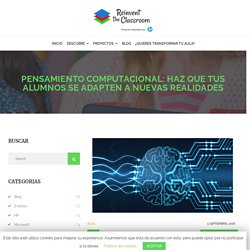
Simplemente, al estar en un mundo centrado en tecnologías, pasamos por alto los objetos qué tienen, o qué no, un refuerzo tecnológico en su interior. CS Discoveries Curriculum Guide 2019 - 2020. SECONDARY national curriculum Computing. CASPrimaryComputing. Computer Science Teachers Association. Framework Statements by Progression – k12cs.org. The K–12 Computer Science Framework is a high-level set of guidelines that informs the development of standards, curriculum, course pathways, and professional development.

Download a complete or abridged copy of the framework statements viewed by progression. Download the entire framework document. Computational thinking for all. Manual de programacion microbit. 5 Ways To Utilize Kids Programming Toys. Posted By christina On July 24, 2019 in Blog “Children are like wet cement.
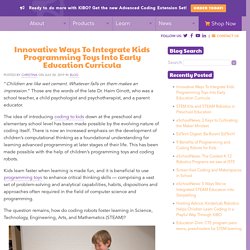
Whatever falls on them makes an impression.” Those are the words of the late Dr. Herramientas para pensar y resolver problemas. Learning Leading final. Csteachers. Remaining trouble spots with computational thinking. Miniprogramadores 5963901cd6149 1.
Cc 2016. Taller Pensamiento Computacional_lecturas compartidas - TEC.LA. YouTube. Computer Science-in-a-Box: Unplug Your Curriculum (2018 Update) Resources. Pensamiento computacional. Unit 1: Introduction to Computer Science. K-2 Computer Science Curriculum. Home - Barefoot Computing Barefoot Computing.
Wing06 ct. Pensamiento computacional Una nueva alfabetizacion digital. Programación y robótica: objetivos de aprendizaje para la educación obligatoria. CompuThinkNordic. National curriculum in England: computing programmes of study. Purpose of study A high-quality computing education equips pupils to use computational thinking and creativity to understand and change the world.
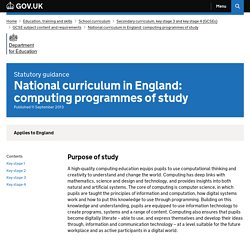
Computing has deep links with mathematics, science and design and technology, and provides insights into both natural and artificial systems. The core of computing is computer science, in which pupils are taught the principles of information and computation, how digital systems work and how to put this knowledge to use through programming. Building on this knowledge and understanding, pupils are equipped to use information technology to create programs, systems and a range of content. Computing also ensures that pupils become digitally literate – able to use, and express themselves and develop their ideas through, information and communication technology – at a level suitable for the future workplace and as active participants in a digital world.
Aims. CSTA K–12 Computer Science Standards - CSTA. Fase 2 Informe sobre la situación en España actualizado y propuesta normativa inf y prim. Hacking STEM: Biblioteca de actividades. CLOQQ - Diviértete y aprende usando las nuevas tecnologías creativas. El pensamiento computacional en el aula. Posibles objetivos para Infantil y Primaria. Nuevos Alfabetismos y Pensamiento Computacional en el Plan Ceibal en Uruguay.
Dr, Cristobal Cobo, director Centro de Estudios Fundación Ceibal El alfabetismo evoluciona a medida que cambian los sistemas de construcción de conocimiento en nuestra sociedad. Why children should NOT be taught to code. There is growing enthusiasm for the idea that children should be taught digital coding.
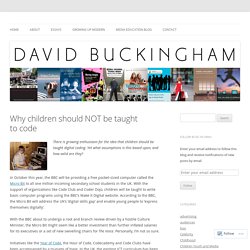
Yet what assumptions is this based upon, and how valid are they? In October this year, the BBC will be providing a free pocket-sized computer called the Micro Bit to all one million incoming secondary school students in the UK. With the support of organizations like Code Club and Coder Dojo, children will be taught to write basic computer programs using the BBC’s Make It Digital website. According to the BBC, the Micro Bit will address the UK’s ‘digital skills gap’ and enable young people to ‘express themselves digitally’. With the BBC about to undergo a root and branch review driven by a hostile Culture Minister, the Micro Bit might seem like a better investment than further inflated salaries for its executives or a set of new swivelling chairs for The Voice. Initiatives like the Year of Code, the Hour of Code, Codecademy and Code Clubs have been accompanied by a tsunami of hype. Cursos online y tutoriales para aprender a programar.
LittleBits RuleYourRoomKit Booklet Spanish v1 3. LittleBits teachers guide 2018. Programamos – Videojuegos y 'apps'. Programacion y robotica 0. EL005857. Robótica. Programación. Pensamiento computacional. Creative Computing. 7 units44 activitiesremixing encouraged download the Scratch 3.0 version of the guide> help learnerscreate new worldswith computing download the Scratch 3.0 version of the guide an introductorycomputing curriculumusing Scratch Scratch 3.0 is here!
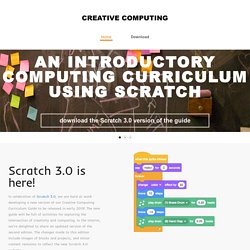
In celebration of Scratch 3.0, we are hard at work developing a new version of our Creative Computing Curriculum Guide to be released in early 2019! Download. Do It With Others. La escuela maker de bq. Electrónica, Robótica, Mundo 3D.
Sneak_peek_creative_computing_curriculum_guide_v3. BBC Bitesize - KS3 Computer Science. BehavioursRubricV34. Computing At School.